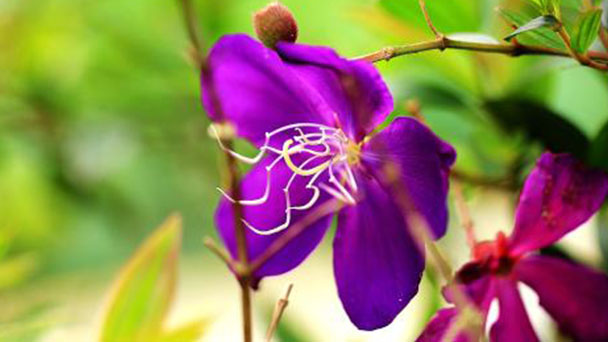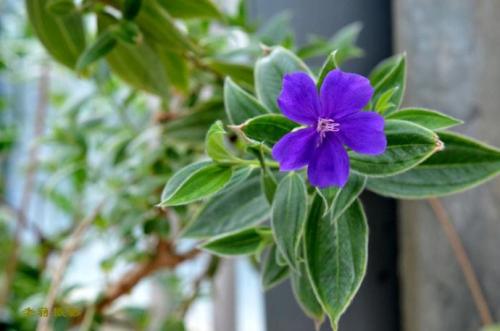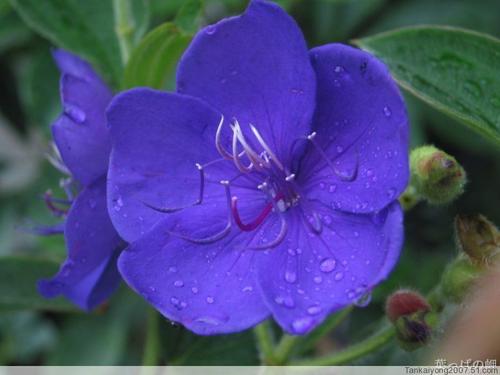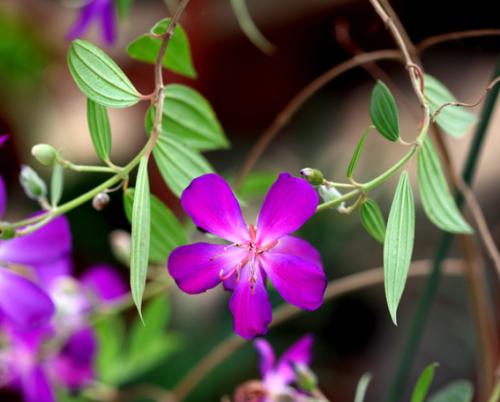Princess flower (Tibouchina urvilleana) profile
Written by Maggie
Mar 12 2021

Princess flowers (Tibouchina urvilleana) are small evergreen shrubs that are 0.5-1.5 m tall. Branches are reddish-brown; Opposite leaves, elliptic to lanceolate, two masks of fine hairs; Flowers are terminal, large, 5-petaled, dark purplish-blue; Calyx has five pieces, red, tomentose; Capsule is altar-shaped globose, a year can be many times flowering. .
Princess flower has delicate plants, long flowering periods and showy flowers, which are very suitable for landscaping and beautification of gardens and green Spaces.
Princess flower picture

Princess flower info
| Botanical Name | Tibouchina urvilleana |
| Common Names | Princess flower, glory bush |
| Plant Type | Broadleaf evergreen shrub or small tree |
| Sun | Full sun (prefers some afternoon shade in the hottest zones) |
| Hardiness Zones | Zones 9 to 11 (USDA); in zone 8, can be grown as perennial that dies back to the ground |
| Flower color | Purple |
| Native Area | Brazil |
| Mature size | 6 to 8 feet outdoors (occasionally to 15 feet), 2 to 3 feet indoors |
Morphological characteristics of princess flower
Stem branches
Princess flowers are evergreen shrubs that are 0.6-1.5 m tall. Stems are four rhomboid, branching, branches reddish brown, plant shape compact and beautiful; Stems and branches are almost glabrous.
Leaf
Leaves of Princess flower are leathery, lanceolate ovate, apically acuminate, basally cuneate, 3 -- 7 cm long, 1.5 -- 3 cm wide, entire, smooth, glabrous, 5-basally veined, abaxially puberulent, basally veined.
Flowers
Princess flower umbels ascending to the apex of branches, subcapitate, with 3-5 flowers; Princess flower has 5 petals; Calyx ca. is 8 mm, densely shorter strigose, apex rounded obtuse, abaxially hairy; Petals are purple, stamens white and supple; The stamens are distinctly elongated and enlarged than the stamens.
Fruit
Capsule of a Princess flower is altar-shaped. The flowers are abundant and dense, and the flowering time of a single flower is 4 to 7 days; The anniversary can almost blossom, August begins to enter the blooming period, until the winter, Xie Hua and then continue to smoke bud blossom, to the next April.
The ecological habits of princess Flower
Princess flowers prefer sunny, warm and humid climates. Princess flowers do not have high requirements on soil, prefer slightly acidic soil. It has strong shade tolerance and cold tolerance. It grows well in a semi-shade environment with green and oily leaves, but the number of flowers is less than that in a full sunshine environment. Winter can withstand certain frost and low temperatures. When the temperature lasts for about a week at 2-8℃, slight red or maroon spots will appear on the leaf edge and tip. When the weather warms up, the green color will be restored and new buds and leaves will be sprouted.
How to grow and care for princess flower
Water & fertilizer
Water and fertilizer management of Princess flower should be adjusted according to its growth condition. Fertilization is generally based on the principle of applying a small amount of compound fertilizer or other organic fertilizer. Brasilia has strong adaptability, the cultivation management can be more extensive, before planting enough basic fertilizer, can meet the needs of the growing period. Growing period and flowering period, the consumption of nutrition is more, we should pay attention to timely and appropriate topdressing, usually use 3% compound fertilizer water solution dousing, 1-2 times a month, winter application of phosphorus and potassium fertilizer can enhance the resistance of plants.In hot and hot summer and dry autumn and winter, water 1-2 times a day to meet the needs of plant growth.
Pruning
Princess flower should be pruned at the right time according to the growth condition of the plant. Proper pruning can help the plant to maintain compact plant shape and make the plant shape more plump and beautiful. Pruning after flowering can promote germination of branches, increase the amount of flowering next time, and adjust the plant shape moderately.
Light
The princess flower prefers full solar however can tolerate partial shade, furnished it nevertheless receives at least five hours of direct daylight every day. In fact, if you are in a specifically warm area, it is an exact thought to supply some shade.
Soil
Princess flower will respect damp, wealthy soil. While the plant does want ordinary watering, it is essential that the soil drains well; princess flowers can ride root rot if the soil is soggy. This plant prefers a barely acidic soil, which can be furnished via soil amendments such as peat moss, or by way of feeding it with an acid fertilizer.
Temperature and humidity
Princess flower can't tolerate an actual frost and will die in return as soon as a frost hits. If you prefer to hold your plant from loss of life returned you can deliver it indoors for the winter. One alternative is to reduce a potted plant again to about eight inches and hold it in the storage or basement. If you do preserve the plant in the dark, water it solely sufficient to hold it from drying out.

How princess flower propagates
Princess flowers can only propagate asexually because they rarely bear fruit, and are generally propagated by cuttings. It can be carried out in spring and autumn.
The selection of cuttings
Cut from the mother tree crown, upper periphery of the growth of robust, full buds, no disease, insect pests, cuttings 10-15 cm long, with 2-3 nodes, the top leaves left half, the rest of the leaves cut off, the end cut into a horseshoe, cut the mouth from the internodes 0.5-1 cm.
Substratum
Cutting substrate requires the selection of loose and breathable, water, fertilizer and rich in organic matter matrix, which can improve the survival rate of cutting. Garden soil, vegetative soil or humus soil can be selected: vermiculite: perlite =3:1:1.
Cuttings
Brasil wild peony is easy to root, do not use rooting agent, cutting depth of 2-3 cm, insert the cuttings into the nutrition bag matrix and gently compacted pouring permeable.
After insert management
The shading net should be covered after cutting. We should keep the substrate wet, timely removal of weeds, pay attention to disease, insect damage to cuttings to timely control. Timely cuttings for topdressing, topdressing combined with watering. We should pay attention to drainage in spring and prevent drought in autumn.
Disease control of princess flower
When the indoor ventilation is not smooth, it is easy to cause the harm of scale insects. When the harm of scale insects is found, a small amount can be artificially peeled off or brushed away with a small brush. When the amount is large, it is sprayed with 1500 times 40% speed fruit cream. When the air is dry, it is easy to produce red butterfly spiders. At the beginning, it is sprayed with 5% thalamoctenone emulsion 1500 times liquid to kill.
The distribution area of princess flower
Princess flower is native to low altitude mountain areas and flat land in Brazil. It has been introduced and cultivated in Guangdong and Hainan of China.
Garden use of princess flower
Princess flowers are large, numerous and dense. The flowers are purple, delicate and beautiful. Princess flower has beautiful plant type, luxuriant foliage, green leaves, flowers all year round. It is simple to cultivate and manage, easy to propagate and adaptable, and it is a rare and excellent plant material for landscape and greening of leaf and flower viewing, which is suitable for application in urban garden and green space. Princess flower can be embellished in the lawn, green land and open space, flowers in the sun appears noble and moving; Princess flower can be arranged in the flower bed mirror, a group of flowers when the bright and dazzling, very spectacular. It can also be planted on both sides of scenic forest road to show its unique green landscape effect. Potted in the house before the house or windowsill, show suburban wild interest, the effect is excellent.
Princess flowers have a certain shade tolerance and are placed under forests and viaducts to provide a new choice for shade tolerance plants.

Latest Updated
- Benefits of Bugleweed - 7 Science-backed Health Benefits
- Bugleweed Dangers & Side Effects - Is It Poisonous?
- How to Plant Evergreen Trees - What You Should Know
- When to Plant Evergreens - Grow Guide for Evergreen Trees
- 12 Wonderful Evergreen Shrubs for Your Garden
- 12 Popular Evergreen Plants with Pictures for Beginners
- When And How To Prune A Lilac Bush Like a Pro
- How to Grow & Care for Lilac Vine (Hardenbergia Violacea)
- Japanese Lilac Tree (Syringa Reticulata) Care & Propagation Guide
- Shumard Oak Pros and Cons - What to Know
Popular Articles
- Winter maintenance of Antirrhinum Majus
- How to Grow Terminalia Mantaly Tree
- How to Grow and Care for Crossostephium Chinense
- How to grow Antirrhinum Majus in spring
- Peristeria Elata (Dove Orchid) Profile: Info & Care Guide
- Underwatered Snake Plant (Sansevieria Trifasciata) - Signs And How To Fix
- How to Care for Brazilian Jasmine Plant (Mandevilla Sanderi)
- How to Grow & Care for Graptopetalum Purple Delight in Summer
- Rosa Chinensis (China Rose): Plant Growing & Care Tips
- How to Care for Baby Sun Rose (Aptenia Cordifolia)